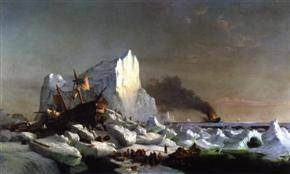
Aurora Borealis, 1865, Frederic Edwin Church, 56 x 83½ inches, oil on canvas, Smithsonian American Art Museum, gift of Eleanor Blodgett

William Bradford – Sealers Crushed by Icebergs (1866)
To the Ends of the World – Painting the Polar landscape
November 8, 2008, through March 1, 2009, at the Peabody Essex Museum
Featuring more than 50 works depicting the drama and magnificence of setting out to sea in the Arctic and Antarctic regions, To the Ends of the Earth, Painting the Polar Landscape opens November 8, 2008, at the Peabody Essex Museum
]]>
“Never before have so many outstanding Western paintings of the Arctic and Antarctic been brought together in one place,” said Sam Scott, PEM associate curator of Maritime Art and History, and curator of the exhibition. “North American, British, and Scandinavian artists captured the awe-inspiring polar landscapes in a variety of ways — documentary, sublime and existential. Some saw the heroic in man’s attempt to conquer the unknown. Others, moved by the landscape’s sheer power and perceived invulnerability, evoked a spiritual response.”
Driven by the promise of adventure, fame and spiritual fulfillment, artists risked their lives to witness scientific missions, personal journeys and officially sanctioned exploration. The polar environment provided ideal scenery for two major maritime painting traditions. William Bradford and Frederic Edwin Church epitomized the romantic sublime approach to landscape in the 19th century by rendering very rugged environments as virtually transcendent visions. A nearly geometric reduction of a grand scene to its elemental qualities was typical of the early modernist works of Rockwell Kent and Lawren Harris, who excelled in conveying the nature of the polar environments through their graphic attributes.
“The works in To the Ends of the Earth emerge from a time when the forbidding polar landscape symbolized nature’s invulnerability to mankind,” said Lynda Roscoe Hartigan, PEM’s James B. and Mary Lou Hawkes Chief Curator. “In light of the climate changes reported almost daily in mainstream and scientific news, these works have an especially poignant resonance for modern viewers.”
Church and the Sublime.
Frederic Edwin Church’s stunning Aurora Borealis (1865) anchors the exhibition. This breathtaking, 7-foot-wide oil painting depicts the northern lights as a brilliant curtain of turquoise, orange and yellow across the polar night sky. Church had journeyed to Labrador and Newfoundland in 1861, searching for icebergs to paint. He created Aurora Borealis, enhanced by his own imagination, in order to convey his quest for the sublime in nature. Visitors to the exhibition will have the rare opportunity to view three of Church’s ice paintings together.
Marston, Shackleton and the Endurance. Artist George Marston shared in the legendary doom of Sir Ernest Shackleton’s fateful 1915 expedition across Antarctica on his vessel Endurance. Trapped by ice, the ship sank stranding the crew on Elephant Island. When Shackleton set out in a small boat in the hope of finding rescuers, Marston sacrificed his oil paints to caulk the hull. Marston’s vivid painting Aurora Australis, the southern lights, was painted in 1908 during Shackleton’s first expedition to the southern continent and is featured in To the Ends of the Earth.
Bradford’s Epic Vision. Of all the artists represented in the exhibition, William Bradford journeyed to the polar regions most, and is known as the quintessential Arctic painter. Bradford’s famous and monumentally scaled Sealers Crushed by Icebergs (1866) depicts a ship wrecked on a mountain of ice. While that painting expressed the crushing power of the Arctic environment, his more intimate Lights of the Aurora (ca. 1869) — not publicly displayed for at least a century — portrays a delicate vision of the same Arctic world.
The Modernist Eye. Rockwell Kent — at the leading edge of a new generation of artists working in the early 20th century — portrayed a deeply personal relationship to the polar environment. Kent traveled to the Alaska in 1919 and to Greenland in the 1930s, writing about his adventures and work. When Admiral Byrd departed on his 1933 polar science expedition, little-known New York cyclorama painter David Abbey Paige went along to document the voyage. While in Antarctica, Paige created a series of pastels — rarely seen since — capturing the beauty of polar light with its strange halos and ethereal effects. Both distilled the essential forms and hues of the polar environment to the purest sense of being there at the farthest reaches of the world.
Follow us on:

